29 years since Grchev-Dinkata designed the Macedonian flag
On 5 October 1995, the 27th session of the Assembly of the Republic of Macedonia adopted the law on the flag , without debate with 110 votes in favor, one against, and four abstentions.[1]
Article 2 of the Law states:
The flag of the Republic of Macedonia is red with the golden yellow sun. The sun has eight sun rays that extend from the solar disk by extension to the edges of the flag. The sun’s rays cross the diagonal, horizontal, and vertical. The diameter of the solar disk is one-seventh of the length of the flag. The center of the sun coincides with the point at which the diagonals of the flag meet. The ratio of the width and length of the flag is one to two.
In addition, a graphic representation of the flag is provided (Fig. 1).
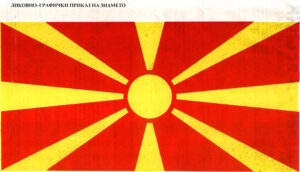
Proposals for the design of a new flag of the Republic of Macedonia were undertaken by Prof. Miroslav Grchev, an architect. The new flag had to be distinct but retain a thematic, visual-symbolic, and identity continuity with state and national flags, with the sun (and the five-pointed star, the sun is a star), and with the colors yellow and red. The basic vexillographic forms of the sun were considered, and for obvious reasons the Kutlesh-type sun was discarded [2](Fig. 2).

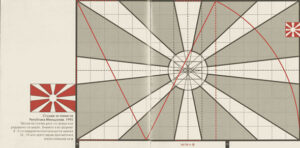
However, the final proposal was amended by Prof. Kostadin Tanchev Dinkata, a fine artist. The original “golden” ratio proportions[3] were changed to 1:2 and the rays were detached from the solar disk by an implied circle. This broke the balanced composition of the circular symmetry of the sun and radial rays that was also symmetrical in a square format.
Dinkata claimed he made the proposal himself, without any connection to Grchev.[4]
Looking at the final design, it is difficult to believe that the original work of Grchev did not underlie the final design by Dinkata. Therefore, the flag should be referred as the Grchev-Dinkata design. Spase Shuplinovski did not work on the design of the flag at all, and in no way can he be considered the flag’s creator in his ideological or other kind of creator.[5]
The new flag was first hoisted on 7 October at the Parliament Building of the Assembly in Skopje, and on 22 October in front of the United Nations headquarters in New York. The flag was welcomed with great resignation, as a symbol of capitulation. It was not hoisted in front of municipalities in Macedonia controlled by the opposition VMRO DPMNE until the next local elections.
The design of the flag is specific, with the red field and divergent sun. Although some of the dimensions of the sun’s design are specified in the Law, some are still undefined and some deviate from the graphic representation of the flag that is part of the Law. The rays of the graphic representation of the flag are not obtained by simply cutting the diagonals of the rectangle, as written in the law, but from a complex structure of the beginnings of the edges of the rays that form a square with a ratio of 3:4 (Fig. 3).
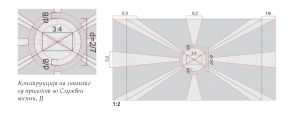
The flag has proportions of 1:2. The disk’s diameter is 1/7 of the length of the flag, i.e., its radius is 1/7 of the height. The sun has two horizontal, two vertical, and four diagonal rays, each set with differing characteristics and different starting points; only the horizontal rays meet at the center of the flag. Their length is 1 unit (E) (height of the flag), their width is 0.2 E, and they subtend an angle of 11.53°.
The state flag is defined as a rectangle with sides 1: 2. But it is often necessary for the flag to have other dimensions. For example, the size of the flags of the participants of the Olympic Games has long been according to the proportions of the flag of the host country. Today the flags are in the proportion of the Olympic flag 2: 3. Or the flags of the countries on the diplomatic cars during the official visits are also with given dimensions.
Or, the flag is used as a part of many logos and graphics, or in document like ID or passports, where the dimensions are less than the prescribed 1:2, but they are actually cut from the original-ratio flag, which makes the flag part asymmetrical as if four more rays are missing to complete the set design symmetry (Fig. 4).
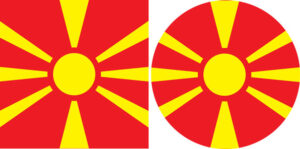
Since the definition of the flag in the Law states that the rays are horizontal, vertical, and diagonal, then the sun should be redrawn for uses in circle, square, and other dimensions (Fig. 5).
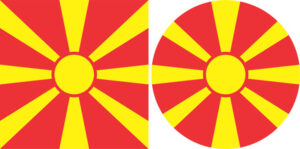
From a vexillographic point of view, the flag’s design attributes changed but the symbols represented did not. The flag remained red with a yellow sun. The sun with convergent rays replaced one with divergent rays, it did not lose its attributes or gain others.
The new flag started to be accepted very slowly. It can be seen today at sporting events, where it is more than half of the flags displayed.
Events that have helped this are being set up on flagpoles in many locations throughout Macedonia. In December 2008, masts 30m high were set up in Skopje on the city square, in front of the Parliament, on the Skopje Fortress and in Bitola. The flag has dimensions of 4m x 8m. In the next two years, many such masts and flags are erected. And the peak of the promotion of the celebrities is the establishment of the flag-changing ceremony accompanied by the intonation of the national anthem in front of the Parliament and the Government of the Republic of Macedonia, which are open to the public, as well as in Vodno – the President‘s palace for invited groups from different backgrounds from students to retirees (Fig. 10). The first ceremonial change of the known was performed in front of the Parliament of the Republic of Macedonia on Saturday, May 15, 2010, conceived to be called „Flag Day“.

But the old flag was never abandoned and is still used by some people, and it has gained in popularity especially after the State had to denounce it under the 2018 Prespa Agreement between Greece and Macedonia—it can symbolize opposition to the change of the name of the Republic of Macedonia to “North Macedonia”. Under that agreement Macedonia was forced to remove any public appearance of the old Kutlesh/Vergina flag—the sun was even ground off of manholes covers. The old flag is seen by some as a national (ethnic) flag, while the new is seen as a state flag.
Jonovski, J. (2022). Историја на македoнското државно знаме – History of the Macedonian National Flag. Македонски хералд – Macedonian Herald, (18), 3-29. https://doi.org/10.47763/mher2218003j
NOTES
[1] Законот за знаме на Република Македонија. „Службен весник на Република Македонија” 47/95.
[2] Grchev, Miroslav (2011), “In Search of the New Flag,” Macedonian Herald 5. Skopje: Macedonian Heraldry Society.
[3] Grchev, Miroslav (2011a), Interview 2011.
[4] Величковски, Владимир (2019), Костадин Танчев – Динката, Скопје: Национална галерија на Македонија, 181.
[5] Јоновски, Јован (2021), „Нов претендент за дизајнот на знамето“, 6.10.2021 https://heraldika.org.mk/news/nov-pretendent-za-dizajnot-na-znameto/ Пристапено/ Accessed on 16.4.2022.



